
The wobbegong is the common name given to the 12 species of carpet sharks in the family Orectolobidae. They are found in shallow temperate and tropical waters of the western Pacific Ocean and eastern Indian Ocean, chiefly around Australia and Indonesia, although one species occurs as far north as Japan. The word wobbegong is believed to come from an Australian Aboriginal language, meaning "shaggy beard", referring to the growths around the mouth of the shark of the western Pacific.

Adalia bipunctata, the two-spot ladybird, two-spotted ladybug or two-spotted lady beetle, is a carnivorous beetle of the family Coccinellidae that is found throughout the holarctic region. It is very common in western and central Europe. It is also native to North America but it has heavily declined in many states and provinces. It is commonly introduced and imported as a biological control agent.

Coccinella transversalis, commonly known as the transverse ladybird or transverse lady beetle is a species of ladybird beetle found from India across southern and southeastern Asia to Malesia and Australia. It is not to be confused with Coccinella transversoguttata, a widespread species in Europe and North America also known as the transverse ladybird. The alternative vernacular of small transverse ladybird may be used for C. transversalis in instances where these two species are discussed together.
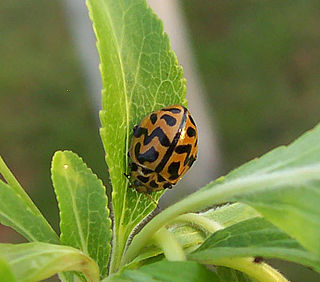
Cleobora is a monotypic genus of ladybird native to Tasmania and the southern states of mainland Australia. Its only recognized species is Cleobora mellyi, the Tasmanian ladybird or southern ladybird.

Coccinella undecimpunctata, the eleven-spot ladybird or eleven-spotted lady beetle, it is native to central Asia, though commonly found in Europe, and formerly North America as its populations are decreasing. It is of the family Coccinellidae, commonly referred to as ladybugs or lady beetles.
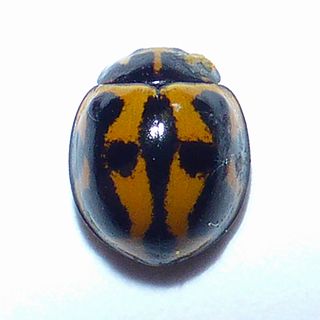
Coelophora inaequalis, the variable ladybird, common Australian lady beetle or common Australian ladybug is a ladybird species endemic to Australia, Oceania and Southern Asia. The variable ladybird gets its name from the black markings on the adult elytra, that vary from one individual to another.

Cryptolaemus montrouzieri, common name mealybug ladybird or mealybug destroyer, is a ladybird species.

Harmonia conformis, the large spotted ladybird, is a species of ladybird. It has a light reddish appearance and its colouration includes 20 large black spots, 18 of which are found on the elytra. They are quite large for ladybirds, being about 6–7 mm long. It is a predator of other insects, eating aphids as both a larva and imago (adult). It is found in Australia, and has been introduced to New Zealand, where it is common in northern regions. Another member of the same genus, Harmonia antipodum, also occurs in New Zealand. This species, however, is a native and is much smaller and harder to find.

Coccinella leonina, common name orange-spotted ladybird, is a species of ladybird native to New Zealand. It is black with orange spots. A predator species, it is present in a variety of habitats.

Harmonia antipodum, known as the antipodean ladybird, is a species of ladybird beetle indigenous to New Zealand, though sometimes mistaken for a related non-native species, Harmonia conformis. They are a brown colour, and about 3 mm long, while H. conformis is much larger and more conspicuously coloured.
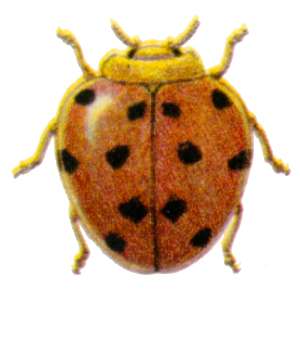
Henosepilachna sumbana, known commonly as the cucurbit ladybird, and sometimes listed as Henosepilachna cucurbitae is a pest ladybird species. H. sumbana feeds on cucurbits; vine-growing fruits such as melons, pumpkins, gourds, and cucumbers.

Henosepilachna vigintioctopunctata is a species of beetle in the family Coccinellidae. It is commonly known as the 28-spotted potato ladybird or the Hadda beetle. It feeds on the foliage of potatoes and other solanaceous crops. It was previously called Epilachna vigintioctopunctata and is a cryptic species complex. It is very often confused with a closely related species, Henosepilachna vigintioctomaculata, which occurs in Russia, China, Japan, and Korea, and is given the same "common name".

Henosepilachna vigintisexpunctata, common name twenty-six-spotted potato ladybird, is a ladybird species.
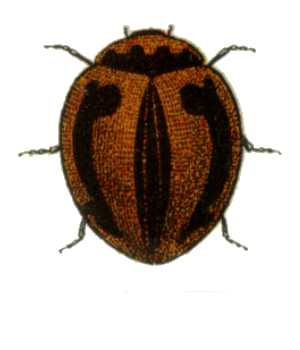
Micraspis frenata, common name Striped Ladybird, is a ladybird species endemic to Tasmania and the mainland eastern states of Australia.
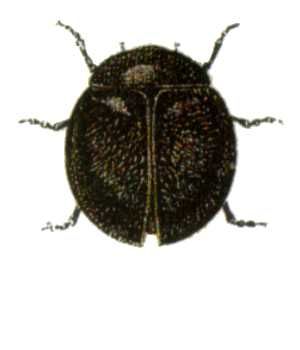
Rhyzobius ventralis, common names including black lady beetle, gumtree scale ladybird, is a ladybird species endemic to Tasmania and all the mainland states of Australia except the Northern Territory. It is also found in New Zealand, but not naturally. The earliest New Zealand record is Auckland, 1898
Diomus pumilio is a species of ladybird. Its common name is Longblack Ladybird. It is found in North America, Oceania and Australia.
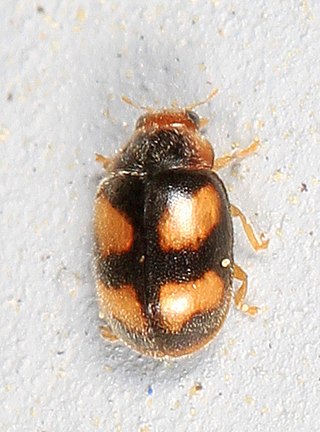
Diomus is a genus of lady beetles in the family Coccinellidae. There are at least 20 described species in Diomus.
Henosepilachna vigintioctomaculata is a species of beetle in the family Coccinellidae. It is commonly known as the 28-spotted potato ladybird, a name also used for the closely related species, Henosepilachna vigintioctopunctata.

Rhyzobius lophanthae, commonly known as the purple scale predator or the scale-eating ladybird, is a species of ladybird native to Queensland and Southern Australia. It was introduced into the United States in the 1890s and has since spread over the southern half of the country.
Scymnus notescens, the Minute Two Spotted Ladybird Beetle, is a species of beetle found in the family Coccinellidae discovered by Thomas Blackburn in 1889. It is found in Australia.

















